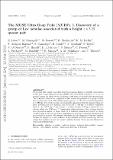The MUSE Ultra Deep Field (MUDF). I. Discovery of a group of Lyα nebulae associated with a bright z ≈ 3.23 quasar pair
Author(s)
Lusso, E; Fumagalli, M; Fossati, M; Mackenzie, R; Bielby, RM; Battaia, F Arrigoni; Cantalupo, S; Cooke, R; Cristiani, S; Dayal, P; D’Odorico, V; Haardt, F; Lofthouse, E; Morris, S; Peroux, C; Prichard, L; Rafelski, M; Simcoe, Robert A.; Swinbank, M; Theuns, T; ... Show more Show less
DownloadAccepted version (1.139Mb)
Open Access Policy
Open Access Policy
Creative Commons Attribution-Noncommercial-Share Alike
Terms of use
Metadata
Show full item recordAbstract
© 2019 The Author(s) Published by Oxford University Press on behalf of the Royal Astronomical Society. We present first results from Multi Unit Spectroscopic Explorer (MUSE) observations at the Very Large Telescope in the MUSE Ultra Deep Field (MUDF), a ≈1.2 × 1.4 arcmin region for which we are collecting ≈200 hours of integral field spectroscopy. The ≈40-h observation completed to date reveals the presence of a group of three Lyα nebulae associated with a bright quasar pair at $z$ ≃ 3.23 with projected separation of ${\approx } 500\rm ~kpc$. Two of the nebulae are physically associated with the quasars which are likely powering the Lyα emission, and extend for ${\gtrsim } 100~\rm kpc$ at a surface brightness level of ≈6 × 10-19 $\rm erg\,s^{-1}\,cm^{-2}\,arcsec^{-2}$. A third smaller (≈35 kpc) nebula lies at a velocity offset of ≈1550 km s. Despite their clustered nature, the two large nebulae have properties similar to those observed in isolated quasars and exhibit no sharp decline in flux at the current depth, suggesting an even more extended distribution of gas around the quasars. We interpret the shape and the alignment of the two brighter nebulae as suggestive of the presence of an extended structure connecting the two quasar host galaxies, as seen for massive galaxies forming within gas-rich filaments in cosmological simulations.
Date issued
2019Department
MIT Kavli Institute for Astrophysics and Space Research; Massachusetts Institute of Technology. Department of PhysicsJournal
Monthly Notices of the Royal Astronomical Society: Letters
Publisher
Oxford University Press (OUP)